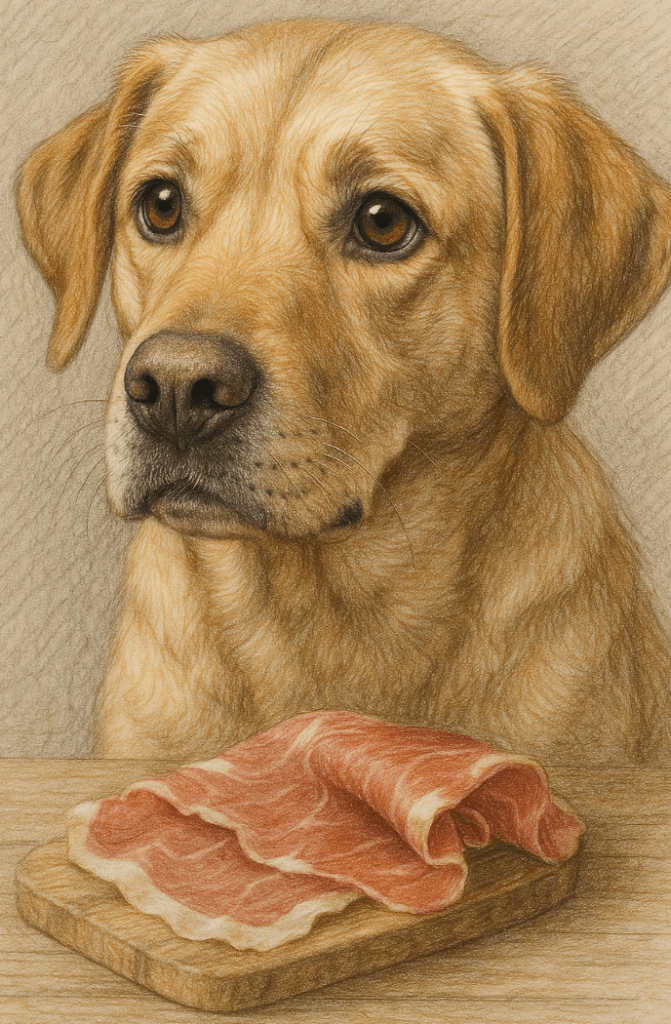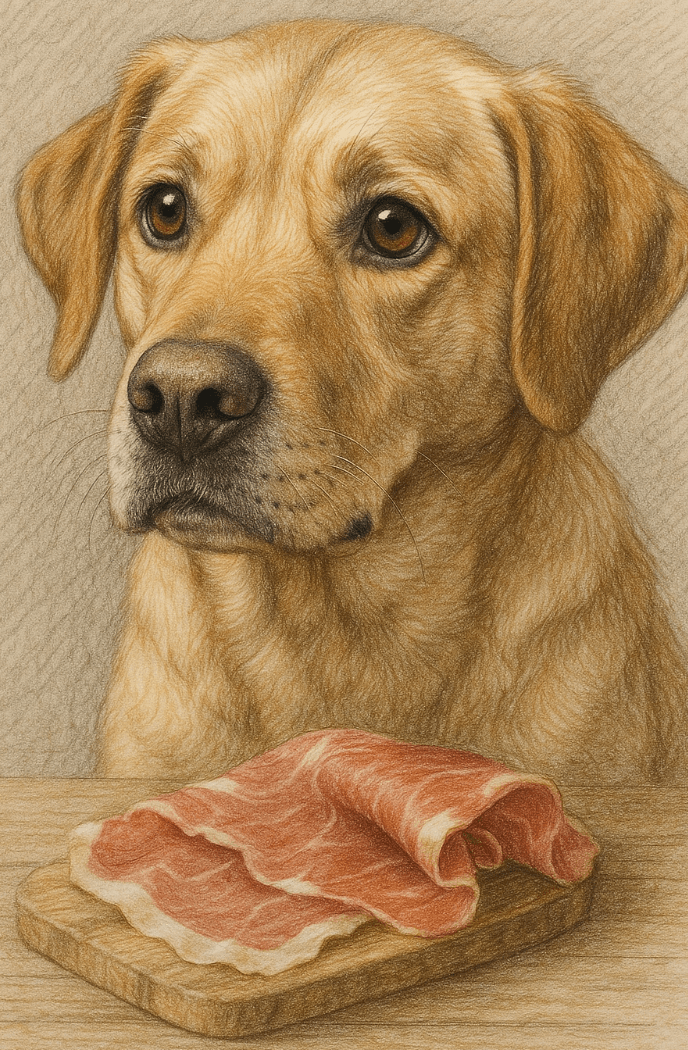Can Dogs Eat Prosciutto? What You Need to Know
Prosciutto, the thinly sliced Italian cured ham, is a delicacy enjoyed by many humans. But what about our four-legged friends? Can dogs eat prosciutto safely, or does it pose risks to their health? While dogs are naturally drawn to meaty treats, not all human foods are suitable for them. Prosciutto, in particular, raises questions due to its high salt content and curing process. In this blog post, we’ll explore whether prosciutto is safe for dogs, its potential risks and benefits, and safer alternatives to consider. By understanding how certain foods affect your dog’s health, you can make informed decisions about their diet and ensure they stay happy and healthy.
Potential Risks of Feeding Prosciutto to Dogs
While prosciutto may seem like a tasty treat, it comes with several risks that pet owners should be aware of before sharing it with their dogs. These hazards can range from digestive upset to more serious health concerns.
High Salt Content:
Prosciutto is heavily salted during the curing process, which can lead to dehydration, sodium poisoning, or kidney strain in dogs.Risk of Pancreatitis:
The fat content in prosciutto can trigger pancreatitis, a painful and potentially life-threatening condition, especially in dogs prone to obesity.Choking Hazard:
Thin slices of prosciutto can clump together and become a choking risk, particularly for smaller breeds or enthusiastic eaters.Additives and Preservatives:
Many cured meats contain nitrates, nitrites, or other preservatives that are harmful to dogs when consumed in large amounts.Difficulty Digesting Cured Meats:
Dogs’ digestive systems are not designed to process heavily processed or cured foods, leading to upset stomachs or diarrhea.
These risks highlight why caution is essential when considering feeding prosciutto to your dog. Always prioritize their safety over indulgence.
Benefits of Lean Meats for Dogs (and Why Prosciutto Isn’t Ideal)
Lean meats are an excellent source of protein for dogs, supporting muscle growth, energy levels, and overall health. However, prosciutto doesn’t fit the criteria for a healthy meat option. Here’s why:
Nutritional Value of Lean Meats:
Chicken, turkey, and beef provide essential amino acids without the added fats, salts, or preservatives found in prosciutto.Digestibility of Plain Cooked Meat:
Unseasoned, cooked lean meats are easier for dogs to digest compared to processed or cured options like prosciutto.Low Sodium Alternatives:
Fresh meats have minimal sodium, reducing the risk of dehydration or sodium toxicity in dogs.No Harmful Additives:
Unlike prosciutto, plain meats don’t contain artificial preservatives or chemicals that could harm your dog’s health.Customizable Portions:
Lean meats allow you to control portion sizes based on your dog’s size and dietary needs, unlike pre-sliced prosciutto.
While prosciutto might tempt your dog with its rich flavor, opting for healthier meat alternatives ensures their nutritional needs are met safely.
Check this guide 👉Can Dogs Eat Acai? Best 7 Expert Tips!
Check this guide 👉Can Dogs Eat Chorizo? Best 7 Expert Tips!
Check this guide 👉Can Dogs Eat Lychee? Best 7 Expert Tips!

Safe Meat Options for Dogs | Risks of Unsafe Meat Choices |
|---|---|
Plain, cooked chicken | Processed meats like prosciutto |
Boiled turkey | Bacon and other fatty cured meats |
Lean ground beef (unseasoned) | Meats with added spices or seasonings |
Fish (boneless and fully cooked) | Raw or undercooked pork products |
Shredded lamb (plain and cooked) | High-sodium deli meats |
How to Safely Introduce Human Foods to Your Dog
If you’re curious about sharing human foods with your dog, it’s important to do so safely. Follow these guidelines to minimize risks and ensure your pup enjoys new flavors responsibly.
Start with Small Portions:
Introduce any new food in tiny amounts to monitor for adverse reactions like allergies or digestive issues.Avoid Seasonings and Spices:
Stick to plain, unseasoned foods to prevent irritation or toxicity caused by common ingredients like garlic or onion powder.Choose Low-Fat Options:
Opt for lean cuts of meat or low-fat snacks to avoid overwhelming your dog’s digestive system.Monitor for Reactions:
Watch for signs of discomfort, such as vomiting, diarrhea, or excessive thirst, after introducing a new food.Consult Your Veterinarian:
Always seek professional advice before making significant changes to your dog’s diet or trying unfamiliar foods.
By following these steps, you can safely experiment with human foods while keeping your dog’s health a top priority.
Signs Your Dog May Be Struggling After Eating Prosciutto
Even small amounts of prosciutto can cause problems for some dogs. Watch for these warning signs if your dog accidentally consumes prosciutto or other unsafe foods.
Excessive Thirst or Urination:
These symptoms may indicate sodium poisoning caused by the high salt content in prosciutto.Vomiting or Diarrhea:
Digestive upset is a common reaction to rich or processed foods like prosciutto.Lethargy or Weakness:
A sudden lack of energy could signal dehydration or another underlying issue related to salt toxicity.Abdominal Pain:
Signs of discomfort, such as whining or reluctance to move, may point to pancreatitis or bloating.Seizures or Tremors:
In severe cases of sodium poisoning, neurological symptoms like seizures require immediate veterinary attention.
Recognizing these signs early allows you to act quickly and prevent further complications.
Common Mistakes to Avoid When Feeding Table Scraps
Feeding table scraps to your dog can be tempting, but it’s easy to make mistakes that could harm their health. Here are some pitfalls to watch out for.
Assuming All Human Foods Are Safe:
Many seemingly harmless foods, like grapes or chocolate, are toxic to dogs. Always research before sharing.Overlooking Portion Sizes:
Even safe foods can cause weight gain or digestive issues if given in excess. Moderation is key.Ignoring Seasonings and Sauces:
Spices, oils, and dressings can irritate your dog’s stomach or contain harmful ingredients. Stick to plain options.Feeding Fatty or Processed Meats:
Items like bacon or sausages can lead to pancreatitis or other health problems. Choose lean, unprocessed proteins instead.Neglecting Veterinary Advice:
Skipping a professional opinion can result in unknowingly harming your dog with inappropriate food choices.
Avoiding these mistakes ensures a safer and healthier experience for your dog.
Healthier Alternatives to Prosciutto for Dogs
If you want to treat your dog to something special without risking their health, there are plenty of alternatives to prosciutto that are both safe and satisfying.
Plain Cooked Chicken Breast:
A lean, protein-rich option that’s easy to prepare and highly digestible for dogs.Carrot Sticks or Green Beans:
Low-calorie veggies provide vitamins and fiber without adding extra fat or sodium.Peanut Butter (Xylitol-Free):
A small dollop of peanut butter can be a tasty reward, as long as it doesn’t contain xylitol.Hard-Boiled Eggs:
Eggs are packed with protein and essential nutrients, making them a great occasional treat.Dog-Specific Treats:
Commercially available dog treats are formulated to meet their dietary needs and preferences.
These alternatives allow you to indulge your dog safely while avoiding the risks associated with prosciutto.
Understanding Your Dog’s Nutritional Needs
Dogs have specific dietary requirements that must be met to maintain optimal health. Understanding these needs helps you make smarter decisions about what to feed them.
High-Quality Protein Sources:
Protein supports muscle development and overall vitality, making it a cornerstone of a balanced diet.Limited Fat Intake:
While some fat is necessary, excessive amounts can lead to obesity or pancreatitis in susceptible breeds.Hydration Is Key:
Ensure your dog has constant access to fresh water, especially if they consume salty or dry foods.Balanced Vitamins and Minerals:
A complete diet includes essential nutrients to support immune function, bone health, and energy levels.Avoid Processed Foods:
Heavily processed items often lack nutritional value and can introduce harmful additives into your dog’s system.
By aligning your dog’s diet with their natural needs, you can promote longevity and well-being throughout their life.
Frequently Asked Questions About Dogs and Prosciutto
Is prosciutto toxic to dogs?
While not inherently toxic, prosciutto’s high salt and fat content make it unsafe for most dogs.
What should I do if my dog eats prosciutto?
Monitor them closely for symptoms like vomiting or lethargy, and contact your vet if you notice anything unusual.
Can puppies eat prosciutto?
Puppies are even more vulnerable to the effects of salty or fatty foods, so it’s best to avoid giving them prosciutto entirely.
Are there safe alternatives to prosciutto?
Yes, plain cooked chicken or turkey makes a much safer and healthier treat for dogs.
How much prosciutto is too much?
Even a small amount can be risky, depending on your dog’s size and sensitivity to salt. It’s safest to avoid it altogether.
Prioritizing Your Dog’s Health Over Temptation
While prosciutto may look appealing to both you and your furry friend, it’s not a safe or healthy choice for dogs. Its high salt content, fat levels, and processing methods pose significant risks to their well-being. Instead, opt for nutritious, dog-friendly alternatives that provide the same satisfaction without compromising their health. Remember, your dog relies on you to make the best dietary choices for them—so always prioritize their safety and happiness above all else. With a little knowledge and care, you can keep your pup nourished and thriving for years to come.
Cat Fever Treatment: Best 7 Expert Tips! Discover expert advice on identifying, managing, and treating fever in cats to ensure their quick recovery and well-being.
Understanding Meloxicam for Cats: Best 7 Expert Tips! Learn how to safely administer meloxicam, manage side effects, and ensure your cat's comfort with expert advice on feline pain relief.
Amoxicillin for Cat UTI: Best 7 Expert Tips! Discover safe usage, dosage guidelines, and expert advice on treating feline urinary tract infections effectively with amoxicillin.
Understanding Cat Cancer Treatment: Best 7 Expert Tips! Discover expert advice on managing feline cancer, from early detection to treatment options, ensuring your cat’s health and comfort.





